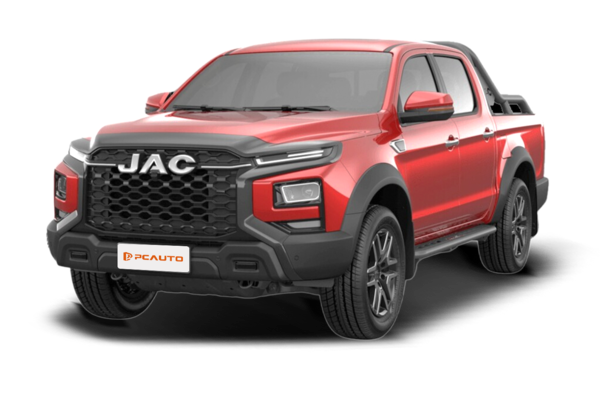Q
Is the JAC T9 hybrid?
Currently, JAC T9 doesn't offer a Hybrid version in the Malaysian market. It's a diesel pickup truck that focuses on practicality and cost - effectiveness. It's equipped with a 2.0L turbo - charged diesel engine, paired with a 6 - speed manual or automatic transmission, which is suitable for cargo - carrying and daily driving needs.
If you're interested in hybrid pickups, you can keep an eye on models from other brands, such as the Toyota Hilux Hybrid or the Mitsubishi Triton Eco Hybrid. These models adopt the hybrid technology, which can balance fuel economy and power performance. The hybrid technology uses the electric motor to assist the engine, effectively reducing fuel consumption. It's especially suitable for the often - congested urban roads in Malaysia and can also reduce carbon emissions.
As the Malaysian government promotes environmental protection policies, more brands may introduce hybrid or electric pickups in the future. It is recommended that you compare the pros and cons of different technologies before buying a car and choose the most suitable model according to your own needs.
Special Disclaimer: This content is published by users and does not represent the views or position of PCauto.
Related Q&A
Q
What is the range of the JAC T9?
As a pickup truck model that focuses on practicality and cost - effectiveness, the range performance of the JAC T9 in the Malaysian market mainly depends on its diesel power configuration. Its fuel tank capacity is approximately 76 liters. Combining with the typical fuel consumption data of the diesel engine, the comprehensive cruising range is expected to reach 800 to 1000 kilometers. The specific figure will vary according to actual driving conditions such as load, road conditions, and driving habits.
For Malaysian users, such a cruising range is sufficient to meet the needs of long - distance transportation or suburban operations. Meanwhile, the characteristics of the diesel engine, which offers high torque at low speeds, are also suitable for hilly terrains and heavy - load scenarios. It's worth mentioning that pickup trucks generally have a better range than SUVs with the same displacement. This is because diesel engines have higher thermal efficiency and the fuel tank design is more functional. If users often travel across states or commute to remote areas, it is recommended to regularly maintain the fuel system to keep the best fuel consumption performance.
In addition, Malaysia has an extensive network of gas stations, and diesel is readily available, which further reduces concerns about energy replenishment during long - distance trips. The mechanical reliability and maintenance cost of the JAC T9 are also practical advantages that local commercial vehicle owners pay attention to.
Q
What is the fuel average per litre of JAC T9?
As a pickup truck model, the fuel economy of the JAC T9 varies according to specific driving conditions, load situations, and engine configurations. Official data shows that the fuel consumption of its diesel - powered models is approximately between 8 and 10 liters per 100 kilometers, which means it can travel about 10 to 12.5 kilometers per liter of diesel. The specific figures may vary slightly depending on whether it's the 2.0T or 2.5T engine version.
For Malaysian users, diesel - powered models have a greater fuel - efficiency advantage in long - distance transportation or heavy - load scenarios. However, the actual fuel consumption is also affected by local road conditions (such as urban congestion or rural roads) and driving habits. It is recommended that vehicle owners regularly maintain their vehicles (such as cleaning the air filter and keeping the tire pressure normal) to optimize fuel consumption. Meanwhile, they can refer to the real - world fuel consumption shares on Malaysian automotive media or owner forums as a practical reference before purchasing a vehicle.
If you have higher requirements for fuel economy, you can also look into the data of pickup truck models from other brands in the same class. However, note that the testing standards of different brands may vary.
Q
What is the wading depth of the JAC T9?
As a pick - up truck model that emphasizes practicality, the JAC T9 has a wading depth of approximately 500 millimeters. This figure is above the middle level among vehicles in the same class, and it can handle the common rain - season waterlogging and mild off - road conditions in Malaysia. The wading depth refers to the maximum water depth that a vehicle can safely pass through without stalling, which is usually determined by the height of the air intake, the sealing of the electrical system, and the chassis protection design. For Malaysian users who often encounter sudden heavy rain, this performance is particularly important. However, it should be noted that when actually wading through water, you should maintain a low and constant speed to avoid water waves rushing into the air intake. After wading, it is recommended to check the braking system.
It's worth noting that different brands may have slightly different testing standards for wading depth. Some manufacturers use the centerline of the wheels or the height of the door sills as a benchmark. Therefore, it is recommended to leave a 20% safety margin in actual use. If you often need to deal with deeper water areas, you can consider installing a snorkel to improve the vehicle's passability, but make sure the modification complies with the original factory's technical specifications.
Q
Is the JAC T9 electric?
Currently, the JAC T9 isn't a pure-electric vehicle. It mainly comes with diesel engine versions, equipped with either a 2.0T or 2.5T diesel engine. This setup meets the Malaysian users' requirements for power and durability in pickup trucks, and it performs well especially in cargo-hauling or off-road scenarios.
However, as a Chinese brand, JAC has been actively venturing into the new energy sector in recent years. For example, it has launched electric pickups or hybrid models in some markets, and there may be an electric version of the T9 in the future.
For Malaysian consumers interested in electric pickups, they can keep an eye on other brands introduced in the local market, such as BYD or Great Wall's electric models. Meanwhile, they should also take into account practical factors like the availability of charging facilities and battery maintenance costs.
Currently, the Malaysian government offers tax incentives for new energy vehicles, but pickup trucks in the market are still predominantly powered by traditional fuels. When making a choice, consumers need to consider both their daily usage and long-term costs.
Q
What is the price of JAC T9 vs Hilux?
The price positioning of JAC T9 and Toyota Hilux in the Malaysian market is different. As an emerging pickup truck model, the price of JAC T9 is relatively affordable. The starting price of the entry - level model is about 80,000 Malaysian ringgit. On the other hand, Toyota Hilux is a long - time best - selling pickup truck with a higher brand premium and greater maturity. The entry - level price usually exceeds 100,000 Malaysian ringgit, depending on the specific configuration and version.
JAC T9 focuses on high cost - effectiveness, offering a turbo - diesel engine and good cargo - carrying capacity. It's suitable for users with a limited budget who also need practical features. Meanwhile, Hilux is well - known for its reliability, powerful off - road performance, and extensive after - sales service network. It's more suitable for consumers who pursue brand reputation and long - term durability.
When making a purchase, it's recommended to compare the configurations of the two models according to your actual needs. For example, compare the engine power (JAC T9's 2.0L turbo - charged engine versus Hilux's 2.4L or 2.8L diesel engines), safety features (such as ABS and the number of airbags), and after - sales warranty policies. You can also consider the resale value. Usually, Hilux performs better in the Malaysian market.
In addition, Malaysian users also need to pay attention to the differences in road tax and insurance costs, as these factors will affect the long - term cost of vehicle ownership.
Q
What is the towing capacity of the JAC T9?
As a pickup model that focuses on practicality, the towing capacity of the JAC T9 in the Malaysian market is just average. According to official data, its maximum towing weight is about 3 tons, which is suitable for daily needs such as towing small yachts, camping trailers, or engineering equipment. This figure is at the mainstream level among pickups with diesel engines in the same class. For example, its towing capacity is similar to that of the Isuzu D - MAX or Toyota Hilux. However, in actual use, it is necessary to pay attention to comply with regulations by considering the vehicle configuration (such as the type of gearbox and the rear - axle ratio) and local laws (in Malaysia, trailers need to be registered and fitted with special license plates).
It's worth mentioning that the towing weight is not a fixed value. It will be affected by factors such as the slope, road conditions, and load distribution. It is recommended that vehicle owners check the vehicle's cooling system, braking performance, and the installation firmness of the tow hook before towing heavy loads. If high - load towing is frequently required, owners can also choose to install the factory - upgraded radiator and transmission oil cooler to improve durability. Such configurations are particularly important in the hot climate of Malaysia.
In addition, the JAC T9 is equipped with a 2.0T diesel engine with abundant low - end torque. Coupled with a part - time four - wheel drive system, it can provide stable traction on complex road conditions such as muddy ground or slopes. However, it is necessary to regularly maintain vulnerable parts such as the clutch plate to ensure long - term reliability.
Q
What is the load capacity of the JAC T9?
As a pickup truck model focusing on practicality, the load capacity of the JAC T9 is a major concern for many Malaysian users. According to official data, the rated load capacity of the JAC T9 is approximately 1.2 to 1.5 tons. The specific figures may vary slightly depending on different configurations and versions. This load - carrying level is sufficient to meet most commercial and daily transportation needs, such as transporting building materials, agricultural products, or small - sized goods.
For Malaysian users, when choosing a pickup truck, in addition to paying attention to the load capacity, they also need to consider the vehicle's power performance and fuel economy. The 2.0 - liter diesel engine equipped in the JAC T9 can provide good torque output, which is suitable for driving on the hilly and rural roads in Malaysia.
Moreover, the size and material of the pickup's cargo box are also key factors affecting its practicality. It is recommended to measure the size of the goods on - site before purchasing the vehicle to ensure a proper fit.
It's worth noting that Malaysia has strict regulations on the load of commercial vehicles. Overloading is not only illegal but also affects driving safety. Therefore, it is essential to abide by local traffic regulations and plan the loading weight reasonably.
Q
Does the JAC T9 have adaptive cruise control?
Based on the current information, the JAC T9 doesn't come standard with the Adaptive Cruise Control (ACC) feature in the Malaysian market. This model focuses more on practicality and cost - effectiveness, with its main configurations concentrated on basic driving assistance systems such as ABS and EBD. Adaptive Cruise Control usually appears in higher - spec or flagship models. It monitors the distance to the vehicle ahead through radar or cameras and automatically adjusts the speed, significantly reducing fatigue during long - distance driving. It's one of the core functions of L2 - level autonomous driving.
If you have a need for this technology, it's recommended that you check the latest configuration table on the official JAC Malaysia website or consult local dealers. Some models may offer it as an option package. Currently, in the Malaysian market, high - spec versions of pickups in the same class, such as the Toyota Hilux and Isuzu D - MAX, have been equipped with ACC, but the price will increase significantly. Consumers can weigh the technological features against practicality according to their budgets. At the same time, keep in mind that you still need to stay focused when using driving assistance systems and can't rely on them completely.
Q
How much is the JAC T9 installment?
The price of the JAC T9 Grand ES is RM 119,888. However, just knowing the vehicle price alone won't let you directly figure out the exact amount of the installment - plan payment. That's because the installment - plan payment involves multiple factors such as the down - payment ratio, loan term, and loan interest rate.
For instance, if the down - payment ratio is 30%, then the down - payment amount is RM 119,888×30% = RM 35,966.4, and the loan amount is RM 119,888 - RM 35,966.4 = RM 83,921.6. Suppose the loan term is 5 years and the annual interest rate is assumed to be 5%. Using the equal - principal - plus - interest formula, the monthly repayment amount is approximately RM 1,612. (This data is just an example calculation, and the actual amount may vary due to bank policies, specific loan plans, etc.)
Since different banks or financial institutions have different interest rates and loan policies, it is recommended that you consult local JAC dealers or relevant financial loan institutions for the specific installment - plan payment amount.
Q
What is the safety rating of the JAC T9?
As of now, there is no officially announced global unified test result (such as ASEAN NCAP or Global NCAP) for the safety rating of the JAC T9. However, based on its relevant configurations and design features in the Chinese market, this pickup truck is equipped with basic safety configurations like dual airbags, ABS + EBD, reverse radar, and a high - strength body structure. Some high - end models may also be equipped with an ESP vehicle stability system and hill - start assist function.
For Malaysian consumers considering purchasing the JAC T9, it is recommended to pay attention to the actual configuration list of local models and refer to the actual test reports of the Malaysian Institute of Road Safety Research (MIROS) or local media, as the configurations of the same model may vary in different markets.
It should be noted that in addition to relying on active and passive safety configurations, driving habits and load balance can also significantly affect the actual road safety of pickup trucks. It is recommended to regularly check the tire condition and braking system. These practical details can often further enhance driving safety.
Latest Q&A
Q
How big is the fuel tank on a 2018 DMAX?
The 2018 D-MAX has a 76-liter fuel tank, a design that meets long-distance driving or heavy-haul needs while still keeping an eye on fuel economy. Diesel engine models usually come with larger tanks because diesel vehicles are more fuel-efficient and have plenty of torque, making them great for frequent hauling or off-roading. It's worth noting that actual range can still be affected by driving habits, road conditions, and load. We recommend checking the fuel level regularly and planning refueling stops accordingly. Most pickups in this class have tanks ranging from 60 to 80 liters, so the D-MAX's 76 liters is above average for the segment—pretty handy for users who often hit construction sites or take long trips. If you want to save more fuel, keep your tire pressure at the right level, avoid sudden acceleration and hard braking, and maintain the fuel system on schedule.
Q
How much is a 2018 D-Max?
The used car prices for the 2018 D-Max vary depending on factors like condition, mileage, trim level, and location. Current market rates are roughly between RM60,000 and RM90,000. Low-mileage, well-maintained high-spec models might edge closer to the upper end, while base trims or higher-mileage examples will be more affordable. This pickup comes with a 3.0T diesel engine, delivering reliable performance and strong off-road capabilities – perfect for users needing to balance cargo hauling with daily driving. Its modification potential is also a hit with enthusiasts. When buying, it's advisable to focus on checking for chassis rust, engine condition, and 4WD system status. If purchasing through a used car dealer, request an inspection report or arrange third-party testing. Additionally, the D-Max benefits from a comprehensive parts supply and service network, making post-purchase maintenance costs relatively reasonable. However, diesel vehicles do require regular fuel system cleaning and DPF maintenance to keep them running at their best. If your budget is tight, you could also consider same-year competitors like the Toyota Hilux or Mitsubishi Triton, but be sure to compare specs and service records thoroughly before deciding.
Q
How big is the Isuzu DMAX 2018?
The 2018 Isuzu D-MAX measures 5295mm in length, 1860mm in width, and 1775mm in height, with a wheelbase of 3095mm. It's one of the roomier options in the midsize pickup segment, offering excellent cargo space and passenger comfort. The cargo bed checks in at 1485mm long, 1530mm wide, and 475mm high, making it ideal for everyday hauling needs. On top of that, its approach angle, departure angle, and ground clearance are all impressive, ensuring solid off-road capability when you need it. Under the hood, the 2018 D-MAX packs a 3.0-liter turbocharged diesel engine that cranks out 177 horsepower and 380 Nm of peak torque. It delivers strong performance while keeping fuel efficiency in check, handling all kinds of road conditions with ease. Inside, you'll find handy features like a multifunction steering wheel, touchscreen infotainment system, and airbags, which boost both the driving experience and safety. As a tough and reliable pickup, the 2018 D-MAX has always been a hit in the market, especially for users who need to balance work and play. Whether you're commuting in the city or heading out for an outdoor adventure, it handles it all without breaking a sweat.
Q
What engine is in the 2018 Isuzu D-Max?
The 2018 Isuzu D-Max comes with two diesel engine options: the 3.0-liter 4JJ1-TC Hi-Power turbocharged diesel and the 2.5-liter 4JK1-TC Hi-Power turbocharged diesel. The 3.0-liter unit cranks out 177 horsepower and 380 Nm of peak torque, while the 2.5-liter engine delivers 136 horsepower and 320 Nm of torque. Both engines are mated to either a 6-speed manual or 6-speed automatic transmission, striking a balance between performance and fuel efficiency. As a pickup truck, the D-Max's engines feature Isuzu's exclusive common-rail fuel injection technology and variable geometry turbochargers, providing strong low-end torque that's perfect for hauling and off-roading, while also keeping noise levels in check. It's worth noting that both engines have stood the test of time in the market, boasting standout durability and reliability in their class, along with reasonably affordable maintenance costs – making them a solid pick for users who frequently drive long distances or need a workhorse for commercial use. Isuzu has deep technical expertise in diesel engines, and the D-Max's engine design prioritizes stability in tropical climates, ensuring it performs well even in hot and humid conditions.
Q
Is the 2021 Volkswagen Arteon a good car?
The 2021 Volkswagen Arteon is a solid all-around performer. It sports a sleek, dynamic exterior with coupe-like flowing lines and frameless doors that give it plenty of personality. Inside, it features VW's family-style design, with solid materials and build quality throughout. The digital cockpit and large infotainment screen add a nice tech vibe. Under the hood, you've got a 2.0T turbo engine paired with a 7-speed dual-clutch transmission, delivering smooth yet ample power. The driving feel leans comfortable but doesn't skimp on sportiness. Space is another strong suit – rear legroom is generous, and the trunk is roomy, making it really practical. Safety-wise, it comes loaded with active tech like adaptive cruise control and lane keep assist. All in all, it's a vehicle that blends good looks, performance, and utility, perfect for buyers who want something stylish and fun to drive. Sure, its price is a bit higher than some competitors, but considering it's imported and the overall quality, it's still good value. For maintenance, VW has a pretty extensive service network and parts availability, so owning it long-term should be hassle-free.
View More












 Cars
Cars




Pros
Cons